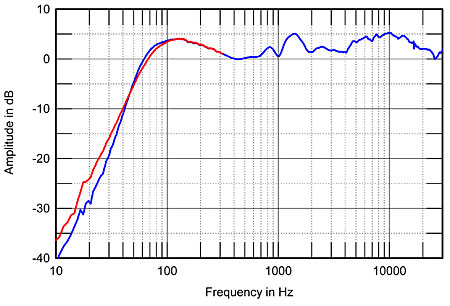| Columns Retired Columns & Blogs |
Denon SC-CX303 loudspeaker Measurements
Sidebar 2: Measurements
I measured the Denon SC-CX303 primarily using DRA Labs' MLSSA system and a calibrated DPA 4006 microphone. The SC-CX303's claimed voltage sensitivity is 86.0dB/2.83V/m; my estimate of this was 85.6dB(B)/2.83V/m, which is within experimental error of the specification. The Denon's impedance is specified at 6 ohms. In fact, the speaker's impedance (fig.1) dipped slightly below 6 ohms in the lower-midrange and midbass regions, and remained above 10 ohms in the low treble; it's really an 8 ohm load that will not make serious current demands on the partnering amplifier, which makes it a good choice for use with inexpensive receivers. Fig.1 was taken with the reflex port on the rear of the cabinet open. Though a supplied foam plug reduces the height of the lower-bass peak in this graph (fig.2), the plug is not substantial enough to turn the speaker into a true sealed-box design.

Fig.1 Denon SC-CX303, electrical impedance (solid) and phase (dashed) with port open. (5 ohms/vertical div.)

Fig.2 Denon SC-CX303, electrical impedance (solid) and phase (dashed) with port sealed. (5 ohms/vertical div.)
The traces in the impedance graph are free from glitches in the midrange, and the sturdy cabinet is indeed free from panel resonances. The only mode I could find was at 109Hz, and though it was present on all surfaces, it was at a low level (fig.3).

Fig.3 Denon SC-CX303, cumulative spectral-decay plot calculated from output of accelerometer fastened to center of side panel (MLS driving voltage to speaker, 7.55V; measurement bandwidth, 2kHz).
The saddle between 50 and 60Hz in the impedance-magnitude curve suggests that the port's tuning frequency lies in this region; the minimum-motion notch in the woofer's nearfield output does indeed occur at 56Hz (fig.3, red trace), and the port's response (fig.4, blue) covers the bandpass between 30 and 120Hz. The port is generally well behaved, though a couple of high-frequency modes are present in its output; one of these, at just below 1kHz, coincides with a small suckout in the woofer's farfield response. The woofer peaks a little in the low treble before crossing over to the tweeter at 3kHz. The tweeter itself appears to be balanced 3–4dB too hot on axis.

Fig.4 Denon SC-CX303, acoustic crossover on tweeter axis at 50", corrected for microphone response, with nearfield responses of woofer (red) and port (blue) plotted below 350Hz and 1kHz, respectively.
Fig.5 shows how these individual outputs sum in the farfield, averaged across a 30° horizontal angle centered on the tweeter axis. The Denon's low-frequency response peaks in the upper bass whether the port is open (blue trace) or closed (red), but most of this apparent boost is a result of the nearfield measurement technique used below 300Hz in this graph. Stopping the port with the foam plug gives only a slight increase in midbass output, but might be useful when the desired speaker placement sounds too rich. "The SC-CX303 had more of an attractive richness of sound than actual deep bass," wrote John Marks, and this graph appears to confirm that. Higher in frequency, the CX303 did have, as JM conjectured, "the inverse of the 'smile EQ' effect," primarily due to the on-axis peak between 1 and 2kHz.

Fig.5 Denon SC-CX303, anechoic response on tweeter axis at 50", averaged across 30° horizontal window and corrected for microphone response, with complex sum of nearfield responses plotted below 300Hz with port open (blue) and closed (red).
The high treble in fig.5 is exaggerated, but as the plot of the Denon's lateral dispersion shows (fig.6), this will be balanced in-room by the rapid drop of the tweeter's top-octave output to the speaker's sides. The CX303's owner can therefore experiment with toe-in to get the most neutral high-treble balance. In the vertical plane (fig.7), a deep suckout develops in the crossover region almost immediately above the tweeter axis, suggesting that the stands used be high enough to place the listener's ears on or just below the tweeter axis.

Fig.6 Denon SC-CX303, lateral response family at 50", normalized to response on tweeter axis, from back to front: differences in response 90–5° off axis, reference response, differences in response 5–90° off axis.

Fig.7 Denon SC-CX303, vertical response family at 50", normalized to response on tweeter axis, from back to front: differences in response 45–5° above axis, reference response, differences in response 5–45° below axis.
The Denon's step response on the tweeter axis (fig.8) tells us that both drive-units are connected with positive acoustic polarity. Though the tweeter's output leads that of the woofer by 250µs or so, the overshoot of its step smoothly blends with the rise of the woofer's step, which correlates with the good frequency-domain integration of their outputs on this axis. However, some ringing can be seen overlaying the decay of the woofer's step, and the cumulative spectral-decay plot (fig.9) confirms that there is some delayed energy associated with the upper-midrange peak in the CX303's on-axis response. This is relatively mild in degree; overall, this waterfall plot is very clean.

Fig.8 Denon SC-CX303, step response on tweeter axis at 50" (5ms time window, 30kHz bandwidth).

Fig.9 Denon SC-CX303, cumulative spectral-decay plot on tweeter axis at 50" (0.15ms risetime).
Its measurements indicate that Denon's SC-CX303 is a well-engineered loudspeaker. It is also beautifully finished, as I have come to expect of Chinese-made speakers, and is competitively priced for the performance offered.—John Atkinson
- Log in or register to post comments




































